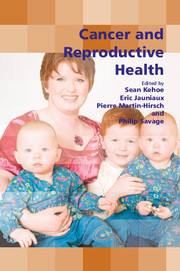Book contents
- Frontmatter
- Contents
- Participants
- Preface
- SECTION 1 Epidemiology, Genetics and Basic Principles of Chemotherapy and Radiotherapy
- SECTION 2 Fertility Issues and Paediatric Cancers
- 5 Assisted reproductive technology for preserving fertility in women with cancer
- 6 Fertility after cancer therapy
- 7 Fertility-preserving surgery in women with cancer of the cervix
- 8 Gonadal function and fertility issues in children and young people treated for cancer
- SECTION 3 Gynaecological Cancers and Precancer
- SECTION 4 Diagnostic Dilemmas
- SECTION 5 The Placenta
- SECTION 6 Non-Gynaecological Cancers
- SECTION 7 Multidisciplinary Care and Service Provision
- SECTION 8 Consensus Views
- Index
8 - Gonadal function and fertility issues in children and young people treated for cancer
from SECTION 2 - Fertility Issues and Paediatric Cancers
Published online by Cambridge University Press: 05 October 2014
- Frontmatter
- Contents
- Participants
- Preface
- SECTION 1 Epidemiology, Genetics and Basic Principles of Chemotherapy and Radiotherapy
- SECTION 2 Fertility Issues and Paediatric Cancers
- 5 Assisted reproductive technology for preserving fertility in women with cancer
- 6 Fertility after cancer therapy
- 7 Fertility-preserving surgery in women with cancer of the cervix
- 8 Gonadal function and fertility issues in children and young people treated for cancer
- SECTION 3 Gynaecological Cancers and Precancer
- SECTION 4 Diagnostic Dilemmas
- SECTION 5 The Placenta
- SECTION 6 Non-Gynaecological Cancers
- SECTION 7 Multidisciplinary Care and Service Provision
- SECTION 8 Consensus Views
- Index
Summary
Introduction
Cancer in childhood is rare, with approximately 1400 new cases per year in the UK and a cumulative risk of around 1 in 500 by the age of 15 years. With long-term survival rates approaching 73%, it has been estimated that, by the year 2010, about 1 in 715 of the adult population will be a long-term survivor of childhood cancer. With improved survival there is a real focus on improving our understanding of the late adverse effects associated with successful treatment. Impaired fertility in both males and females and adverse pregnancy outcomes following successful treatment of cancer in childhood are the subject of this chapter.
Normal ovarian function
In the human ovary, the oogonia that arise from primordial germ cells in the yolk sac reach a maximum complement of 6—7 million by the sixth month of gestation. This represents the total fixed number of germ cells available. Primordial follicles consist of a primary oocyte surrounded by a single layer of spindle-shaped cells. The numbers of germ cells decline in vivo such that there are approximately 2 million primordial follicles present at birth. By a process of continuing apoptosis and attrition, approximately 400 000 primordial follicles are present at the time of menarche. The number continues to decline steadily throughout life. The ‘fertile window’ in females is characterised by roughly 400 monthly ovulations of a mature oocyte.
Keywords
- Type
- Chapter
- Information
- Cancer and Reproductive Health , pp. 101 - 108Publisher: Cambridge University PressPrint publication year: 2008



